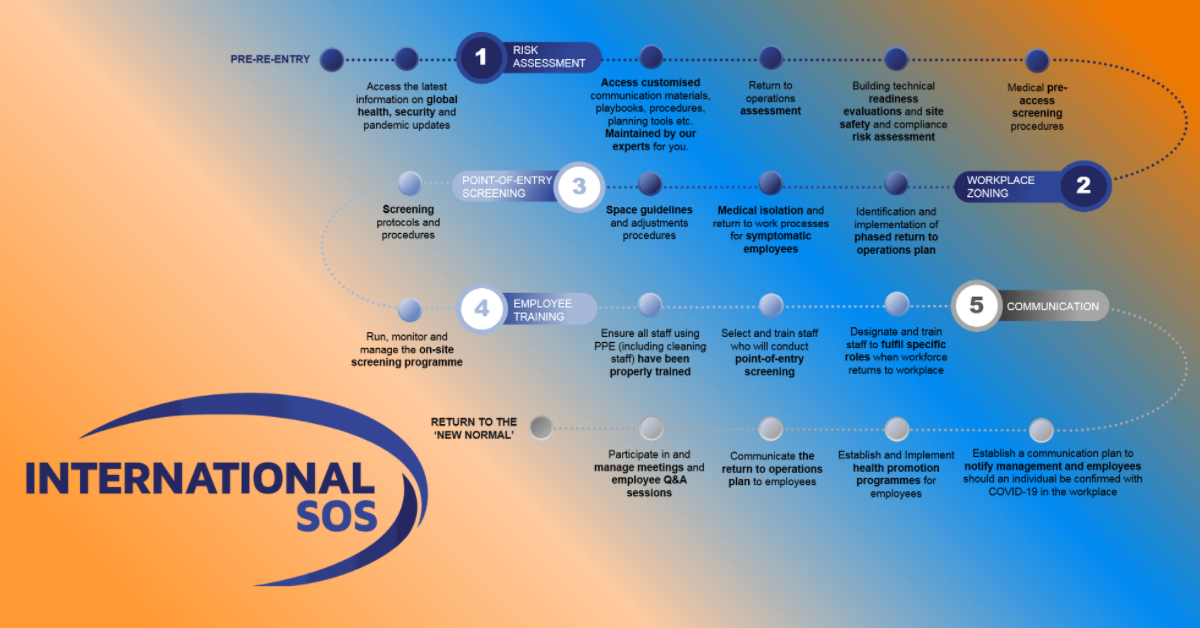With the quarantine restrictions in the National Capital Region (NCR) lowered to Alert Level 3 these past few weeks, more businesses are expected to reopen very soon. The relaxed restriction has enabled service-oriented businesses to serve more clients face-to-face and allowed organizations to gradually increase their operational capacity and on-site workforce.
As the number of COVID-19 cases continues to drop, the Department of Health (DOH) has explored the possibility of further de-escalating the restrictions in the coming weeks. Although the easing of restrictions is a nod towards a healthier economy, some employers and business owners remain uncertain of the proper implementation of return to workplace protocols.
In a learning session with the American Chamber of Commerce, Andrew Candelet, General Manager of International SOS Philippines, emphasized that organizations should immediately prepare airtight return-to-work policies to ensure the safety of their employees and their businesses during the transition.
“The increasing vaccination numbers slowly builds towards herd immunity. We appear to be entering a new phase with the pandemic gradually transitioning to endemic. This is when the virus still survives in the community, but fatality rates are lower, and the healthcare system is better able to cope. This gradual transition has prompted organizations to think about how they can safely repopulate their workplaces,” according to Candelet.
The International SOS Philippines executive pointed out that aside from being agile and responsive, companies need practical back-to-work plans that abide by local guidelines such as those from the Department of Trade and Industry (DIT) and Department of Labor and Employment (DOLE).
International SOS, the world’s leading health, travel, and security solutions provider, identified possible workplace issues that could arise during the back-to-work transition, particularly those concerning vulnerable employees.
“Organizations that are planning to return to the workplace should be flexible and always remain updated with the latest government guidelines to maintain a level of safety. DTI and DOLE Workplace Prevention and Control of COVID-19 guidelines are serious considerations for companies that plan to have employees report to their headquarters. These include providing clear company policies, resources and materials, assignment of safety officers, enhanced health insurance, shuttle services, and accommodations, local community hiring, and a COVID-19 hotline for employees,” Candelet added stating that organizations should consistently engage, communicate, and address the concerns of their staff to ensure their physical well-being and productivity.
Employers should remain respectful of unvaccinated employees and staff fearful of working in enclosed, shared workspaces. Organizations, instead, should have the foresight to provide alternative work areas for them as needed.
“An organization’s ability to step up or step down its operations during a surge or afterward affects business continuity. The best way to protect your organization is to have regular testing, quarantine, social distancing, and sound health policies at the office,” said Dr. Carrianne Ewe, Medical Director of International SOS Philippines, seconded this by forewarning business leaders to brace themselves for cyclical incidences of COVID-19 infection surges and declines as the pandemic slowly transitions to endemic.
To help organizations through the complex process of safely returning to the workplace, International SOS has also developed the integrated solution WorkSafe that enables companies to safeguard their people, fortify their business while boosting cost efficiency, adhere to health and safety regulations, protect the immediate community, and maximize digital tools like the AOKPass, a blockchain-based digital health certification, co-founded by the International Chamber of Commerce (ICC).
Resuming business operations on-site is a complex process that requires much planning and preparation for the management and its workforce. With thorough planning, the right tools, and a cautious approach, organizations may soon see a number of their employees face-to-face rather than through a screen.
More information on How to Safely Return to the Workplace is available here.


